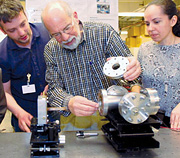Efficient photovoltaic power—without the sun
MIT researchers are devising an electricity-producing device that would let resting truck drivers run the lights and air conditioners inside their cabs without keeping their big rigs idling all night. The new device is a high-tech combination of a small flame and a power-generating solar cell.
In most cars and trucks, an alternator uses the mechanical power of the engine to generate electricity for the headlights, windshield wipers, and so on. But that setup is not fuel efficient: engines generally convert only about a third of the energy in fuel into work, and running the alternator makes things worse. Worst of all is wasting all that energy to make electricity when the car or truck isn’t moving.
Professor John G. Kassakian of electrical engineering and computer science and his colleagues in MIT’s Laboratory for Electromagnetic and Electronic Systems are developing a cleaner, more efficient way to provide the needed electricity. Their device takes advantage of the ability of photovoltaic materials to turn light into electricity.
Since sunshine isn’t an option, they get their light from a cylindrical element made of tungsten, the material used in light-bulb filaments. A burner fueled by injected gasoline or diesel heats the tungsten cylinder to about 2,200 degrees Fahrenheit. The intense light of the hot cylinder shines on a photovoltaic diode (similar to a solar cell), which delivers electricity. Unlike the main engine, which involves rotating shafts and reciprocating pistons, this device contains no moving parts.
According to Kassakian, the concept—called thermophotovoltaics (TPV)—has been around for some 50 years. But despite extensive work by many researchers (including Kassakian himself), TPV systems had remained inefficient and expensive.
Now, however, his research team has designed a TPV device that may ultimately convert much more of the fuel into electrical power. “New semiconductor materials and the science of photonics now permit us to create a far more effective energy system,” said Kassakian.
New materials have yielded photo diodes that are highly efficient at converting light into electricity. However, they respond only to certain wavelengths. The researchers therefore etch the surface of their light source—the tungsten cylinder—with tiny pits, or “nano-holes,” so that it selectively emits the wavelengths that the photo diodes like best.
Since that system isn’t perfect, they also surround the tungsten cylinder with a filter of thin silicon and silicon-dioxide layers that act as selective mirrors, letting the desired wavelengths through and reflecting back the rest. The reflected light helps keep the tungsten glowing hot, reducing the amount of fuel required.
A small prototype capable of demonstrating the device’s capabilities may be ready in a year. But many tasks remain, among them finding methods of cooling the hot diodes, examining other materials that may perform even better, and seeing whether the high efficiency persists as the device gets bigger.
The researchers' initial focus is on automotive systems. One intriguing application is in hybrid autos. A hybrid saves fuel by shutting off the engine when the car is stopped, say at a traffic light. But the hybrid's battery drains quickly when it must run the radio, lights, and air conditioner--and then restart the engine when the light turns green. The TPV device could generate the needed electricity.
The team is now designing a supplement to the TPV system that uses the excess heat from the tungsten light source to power the air conditioner. The result would be a highly efficient combined system that could effectively use more than half the energy in the fuel. An important application would be in large trucks, which may no longer be allowed to idle their engines to provide electricity and air conditioning while drivers sleep at highway rest stops.
Other potential applications of the TPV system include providing power in remote locations and serving as a portable source of power.



